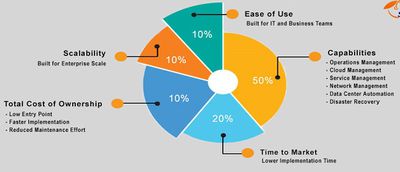IT Operations Management (ITOM)
IT Operations Management (ITOM) involves technology infrastructure components and requirements of individual applications, services, storage, networking and connectivity elements within an organization. In other words, IT Operation Management is responsible for the smooth functioning of infrastructure and operational environments that support application deployment to internal and external customers, including network infrastructure; server and device management; computer operations; IT infrastructure library (ITIL) management; and help desk services to an organization.[1]
IT operations management (ITOM) software is intended to represent all the tools needed to manage the provisioning, capacity, performance and availability of the computing, networking and application environment. Gartner divides the ITOM market into 10 major segments that include DBMS, application management, availability and performance, event, fault and log management, network management, configuration management, IT services desk and IT help desk, asset management, job scheduling and other ITOM (which refers to output management software) for tools used to manage hardware peripherals, such as printers.[2]
IT Operations Management (ITOM) Challenges[3]
Effective IT Operations Management (ITOM) requires an integrated, service-centric approach, one that maximizes business service quality, drives efficient processes, enables innovation, and ensures robust governance. However, many IT teams still wrestle with multiple, unintegrated ITOM tools. As a result, they suffer from service outages and cloud complexity. Despite investing in new tools, companies continue to experience business service outages, which negatively impact customers, partners, and employees—resulting in financial losses and damage to company reputation. IT teams continue to manually stitch together disconnected data from multiple monitoring tools rather than have a clear, real-time view of business service and IT Infrastructure health. They struggle to detect, diagnose, and resolve service issues, and the result is yet more frequent and more severe service outages. Moreover, as the demand for cloud resources grows, so does the complexity to manage them. Cloud challenges include having different systems to manage each cloud environment, inconsistent service catalogs, limited cost and usage visibility of cloud resources, and high expectations from users and businesses that want immediate results.
Requisites Of A Modern IT Operations Management Platform[4]
IT Operations Management forms the backbone of for enterprises who rely heavily on IT for delivering products and services to their customers. IT Operations management software is a blanket term used to describe any software application which helps in managing IT Services rendered to customers, partners or even employees. This could be as complex as running the Online Banking platform of a large bank to as simple as handling IT Asset requisitions from new employees. The spectrum is quite wide and diverse and one must deliberate before buying a modern ITSM Service Management platform. The infographic below illustrates 5 key requisites of a modern ITOM Platform
Capabilities, Features and Modules
This forms the core tangible for any modern ITOM Software platform. Here are six capabilities which any modern ITOM Software platform should have at the least.
- Operations Management:Your IT Operations Management platform should have the capability to monitor every component of your Hybrid Infrastructure. Whether its servers, networks, applications or composite IT components.
- Cloud Management: Cloud forms a major vehicle for today’s enterprise. Given the nature of business everything seems to be residing on the cloud whether its core business applications, servers or even files. Businesses need a solid cloud management software to manage hybrid cloud which are engrained into the enterprise fold.
- Service Management Automation: As the name suggests every modern ITOM software should be able to automate all IT Processes and Tasks which are repetitive in nature.
- Network Management: Modern Networks are spread across offices, locations and even continents. You will need capabilities to manage your networks in a seamless manner.
- Data Center Automation: Enterprise applications get updated at a rapid pace. Data Center automation enables you to automate provisioning, patching and compliance across multivendor physical and virtual servers, databases, and middleware for enterprise-scale deployments.
- Scalability:An ITOM platform is meant for a large organization and must be able to scale its operations whichever platform you select, make sure it can handle the load of your ever growing IT Infrastructure and business needs.
- Ease of Use: What good is an ITOM platform if it is too difficult for the users to manage? The real users of the platform are your IT personnel and customers. This is why it is important to ensure the platform is easy to use and offers complete control to the users. An expert ITOM consultant can help you in the process of integrating all of your existing technology solutions with your ITOM software platform.
- Time to Market: Business and technology are changing rapidly. Gone are the days where ITOM implementations used to take a year. A modern ITOM platform should be implemented in a matter of weeks, so that business can drive value from your IT investments.
- Total Cost of Ownership: You should measure the overall total cost of ownership (TCO) of your ITOM software platform over a period of one year. Low entry point doesn’t guarantee lower TCO. The amount of time, effort and skills spent on implementing, maintaining and running your ITOM platform determines the overall spend for the business.
See Also
References
- ↑ Definiiton - What Does IT Operations Management (ITOM) Mean? E-Spin Corp
- ↑ What is IT operations management (ITOM) software Gartner
- ↑ IT Operations Management (ITOM) Challenges ServiceNow
- ↑ Requisites Of A Modern IT Operations Management Platform ServiceBerry


